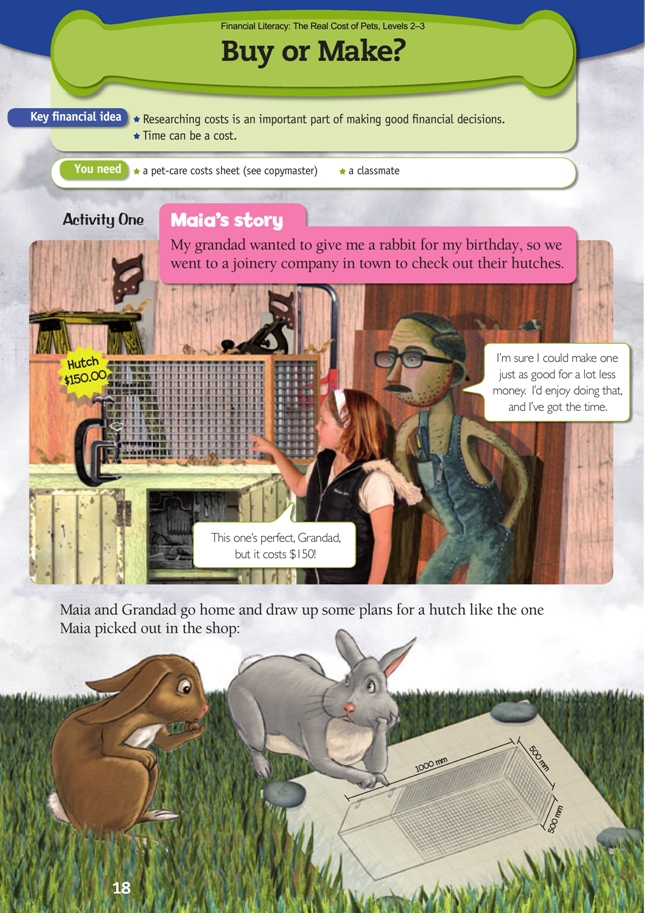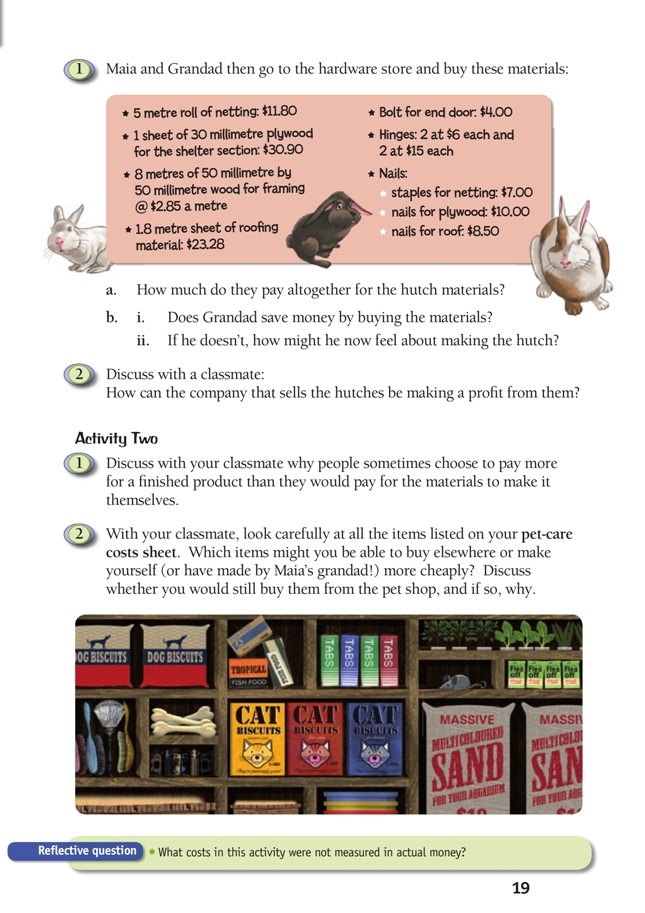This is a level 3 number and algebra activity and a level 2 statistics activity from the Figure It Out series. It relates to Stage 5 of the Number Framework.
A PDF of the student activity is included.
Click on the image to enlarge it. Click again to close. Download PDF (2042 KB)
use mental strategies to add money amounts
Number Framework Links
Students at stage 5 could use a calculator to assist them but will need teacher support to understand the numbers being used. Alternatively, the prices could be altered to whole numbers, and the students could then work relatively independently and make more sense of the answers.
Students at stage 6 should be able to use some numeracy strategies, including written form, to solve the problems in these activities.
FIO, Levels 2-3, Financial Literacy: The Real Cost of Pets, Buy and Make? pages 18-19
A classmate
Activity One
Financial understanding
In this activity, the students learn the importance of researching all the costs of a project before they decide whether to make a product themselves or buy it from a retailer. This activity emphasises that there is a consequence for each financial decision we make; a good financial decision brings benefits.
Maia and Grandad are collecting, organising, and analysing information when they investigate the cost of all the materials needed to build a rabbit hutch.
One way to introduce this activity would be to brainstorm whether it is better to buy or make things. For example, you could open with a discussion about school lunches: Is it better/cheaper to make your own or to buy?
Is this always the case?
Mathematics and statistics
To do this activity, the students will need to understand the measurement units required. For students at stages 2–3, a more valuable exercise may be to have them design a rabbit hutch that is different in shape and size from the one shown and to discuss the differences with each other.
All the students could join in a discussion of question 1b ii. You might choose to link this discussion to Activity Two, question 1.
Activity Two
Financial understanding
The students generate and use creative ideas and processes when they think of cheaper ways to obtain items on the pet-care costs sheet.
From the discussion in this activity, the students will learn that the amount of time and energy put into a project is also a cost. Even though that cost may not necessarily be financial, it may affect how well off the people involved are now and in the future. The trade-off (opportunity cost) for Grandad, in terms of enjoyment and challenge,
probably means that this is not an issue for him, but there are times when it is. For example, a company needs to consider the relative merits of:
• having an employee spend half an hour hand-delivering a package that could have been couriered for very little cost
• a person on a very high salary doing tasks such as photocopying or filing that could be done by someone on a much lower salary.
Ask: Is that a good use of that person’s time at work? What could they be doing instead?
The students could discuss at home what decisions are made with the “cost of time” taken into account and what decisions are made without considering time. For example, do they buy biscuits or make them? Why or why not?
What other examples can they find?
Social Sciences Links
Achievement objectives:
• Understand how people make choices to meet their needs and wants (Social Studies, level 2)
• Understand how cultural practices reflect and express people’s customs, traditions, and values (Social Studies, level 2)
• Understand how people make decisions about access to and use of resources (Social Studies, level 3)
The students could discuss what has caused the change over time from people being almost self-sufficient into a society where most businesses specialise in the products they make and sell:
– Why did most of our grandparents sew, knit, or make their own clothes whereas now most people buy everything? (Economies of scale and the economic return from specialisation)
– Why might some people still choose to sew, knit, or do other handcrafts?
Other Cross-curricular Links
Health and Physical Education achievement objective:
• Safety management: Identify risks and their causes and describe safe practices to manage these (Personal Health and Physical Development, level 3)
The students could discuss what they would need to be careful of if they were to help Grandad make the hutch.
Technology achievement objective:
• Brief development: Describe the nature of an intended outcome, explaining how it addresses the need or opportunity. Describe the key attributes that enable development and evaluation of an outcome (Technological Practice, level 3)
To extend the students, you could have them do one or more of the following tasks:
– Design their own hutch for a rabbit or similar pet and then evaluate their designs in terms of whether they are affordable, realistic, and practical.
– Complete other design briefs, for example, for other animals, different numbers of animals in a cage, and so on.
– Measure and draw a scale design of an existing pet cage.
– Research the cost of producing a cage for sale and whether this could be done for a profit.
– Design a bird table. The challenge could be to do this as cheaply as possible or it could be to make one for the school grounds or at home.
Science achievement objective:
• Life processes: Recognise that all living things have certain requirements so they can stay alive (Living World, level 2)
The students could discuss: What would you need to consider for the health and safety of the animals in the cage? How often would you need to clean the cage, and how easily could you clean it?
The students could research different animals and find out what their requirements for housing would be.
This could also be extended into what animals each child could have at home, depending on their situation.
Answers to Activities
Activity One
1. a. $160.28
b. i. No. The hutch from the shop was$150.00.
ii. Answers will vary. Grandad may still possibly be pleased because he enjoyed
making the hutch and spending time with his granddaughter; he may have
produced a better product than the manufactured ones. Alternatively, he
may wish he’d thought about the time versus costs more carefully and used the
time for something else.
2. Answers will vary. The company will be making a lot of hutches, so they would get the materials much cheaper by buying in bulk, even though they have to pay for labour. There would also be a lot less wastage. For example, nails can come in boxes of 100; the company would use them all, whereas Grandad might never need to use the leftover nails.
Activity Two
1. Answers will vary. They may not have the skillsneeded to make the product or to make it as well, they may not have the time needed, or they may not be interested in making it.
2. Discussion will vary.
Reflective question
Answers may vary. The main cost is time, for drawing the design, going to the hardware store and sorting out the materials needed, and making the hutch. (However, for some people, time is not an issue, and they enjoy spending that time and the
result.)

